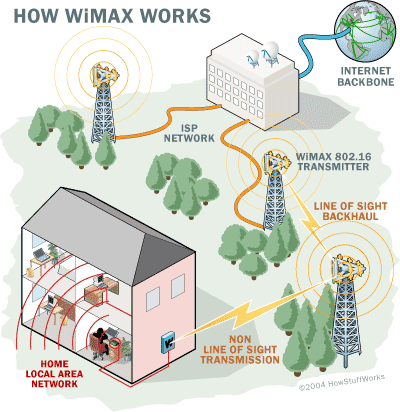WiMax (802.16e) is a newer standard of wireless networking designed to provide the last mile of high speed internet access to the end user. Some people would call Wimax WiFi on steroids but this would be to broad of an assessment. Wifi was and still will be used in LAN environments for the foreseeable future. WiMax was designed to provide (MAN) Metropolitan Area Access, to homes and businesses.

WiMax base stations will have the ability to provide approximately 60 businesses with T1 access and hundreds of homes with DSL/Cable speed access…in theory. Engineers are stating that WiMax has the capability of reaching 30 Miles but real world testing has shown 4-8 mile working radius.
WiMax (MAN) deployments are similar to a WiFi network. First the ISP would have their T3 or higher access. The ISP would then use line of sight antennas (Bridges) to connect to towers that would distribute the non line of sight signal to (MAN) residential/business clients.
WiMax line of sight antennas operate at a higher Frequency up to 66mhz. Distribution antennas do not have to be in the line of sight with their clients. Non – line of sight towers operate on a range similar to WiFi . WiMax can operate right next to cell phone towers with no interference.
WiMax networks are similar to Wifi in deployment. The Wimax Base station/Tower will beam a signal to a WiMax Receiver. Similar to a WiFi access point sending a signal to a laptop. As far as I can tell laptops will be shipping with Wimax receivers in 2006.
QOS (Quality of Service) is an major issue with WiMax because of the number of people accessing a tower at once. Some would think that a tower could be easily overloaded with a lot of people accessing it at once. Built into the WiMax standard is an algorithm that when the tower/base station is nearing capacity then it automatically will transfer the user to another WiMax tower or cell. Unlike a Wifi clients who have to kind of fight to stay associated with a given access point; WiMax will only have to perform this hand shake at the MAC level the first time they access the network.
WiMax is designed for building a network infrastructure when the environment or distance is not favorable to a wired network. Also, WiMax is a cheaper and quicker alternative than having to lay wire. Third world countries will greatly benefit from deploying WiMax networks. WiMax can handle virtually all the same protocols Wifi can including VOIP. African countries are now going to start deploying WiMax networks instead of cell phone networks. Disaster zones can also utilize WiMax giving them the ability to distribute crisis information quickly and cheaply.
Militaries are already using wireless technology to connect remote sites. Logistics will be simplified with the ease of tracking with RF technologies. WiMax can also handle Webcams and streaming video which would give commanders eyes on target capability. Just imagine if planes were able to drop preconfigured self deploying WiMax antennas in strategic areas giving troops real time battlefield intel. Armed with wireless cameras, drones and a GPS one soldier would truly be an Army of One.
As WiMax is deployed in more areas theory and real life capabilities of WiMax will come to light. The differences between WiMax and Wifi are simple. Think of a WiMax network as an ISP with out wires, with the signal providing your internet access to your business/ home. Wifi will be used within in your LAN for the near future.
Other interesting websites
- Casinos Not On Gamstop
- Migliori Casino Non Aams
- Siti Non Aams Legali In Italia
- Casino Not On Gamstop
- UK Casinos Not On Gamstop
- UK Online Casinos Not On Gamstop
- Casino Online Non Aams
- Beste Online Casino Deutschland
- Best Non Gamstop Casinos
- Casino Sites Not On Gamstop
- Meilleur Casino En Ligne
- Online Casino Zonder Cruks
- UK Online Casinos Not On Gamstop
- Casino Sites Not On Gamstop UK
- Casinos Not On Gamstop
- Casinos Not On Gamstop
- Casino En Ligne
- Casino Sites Not On Gamstop
- Casinos Not On Gamstop
- UK Online Casinos Not On Gamstop
- Casinos Not On Gamstop
- Casinos Not On Gamstop
- Slots Not On Gamstop
- Casino Online Migliori
- Casino Crypto
















